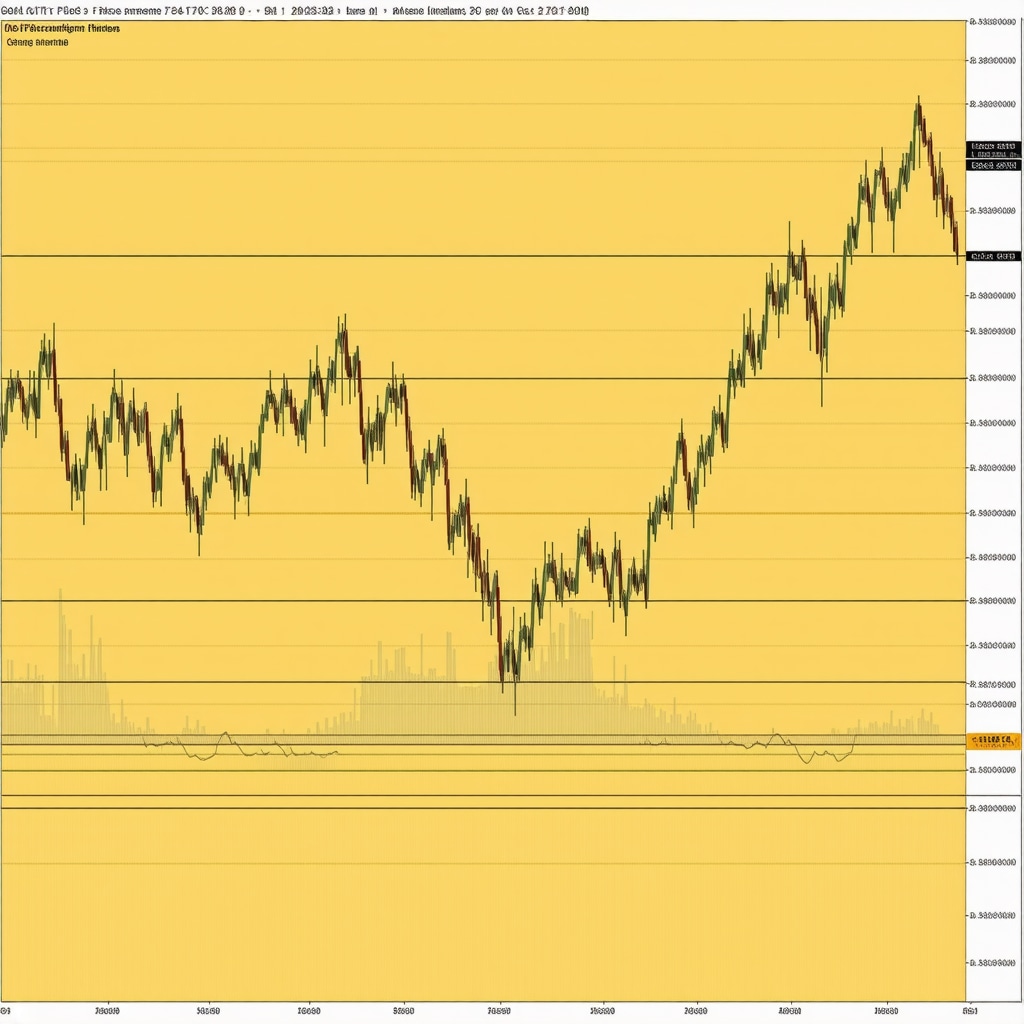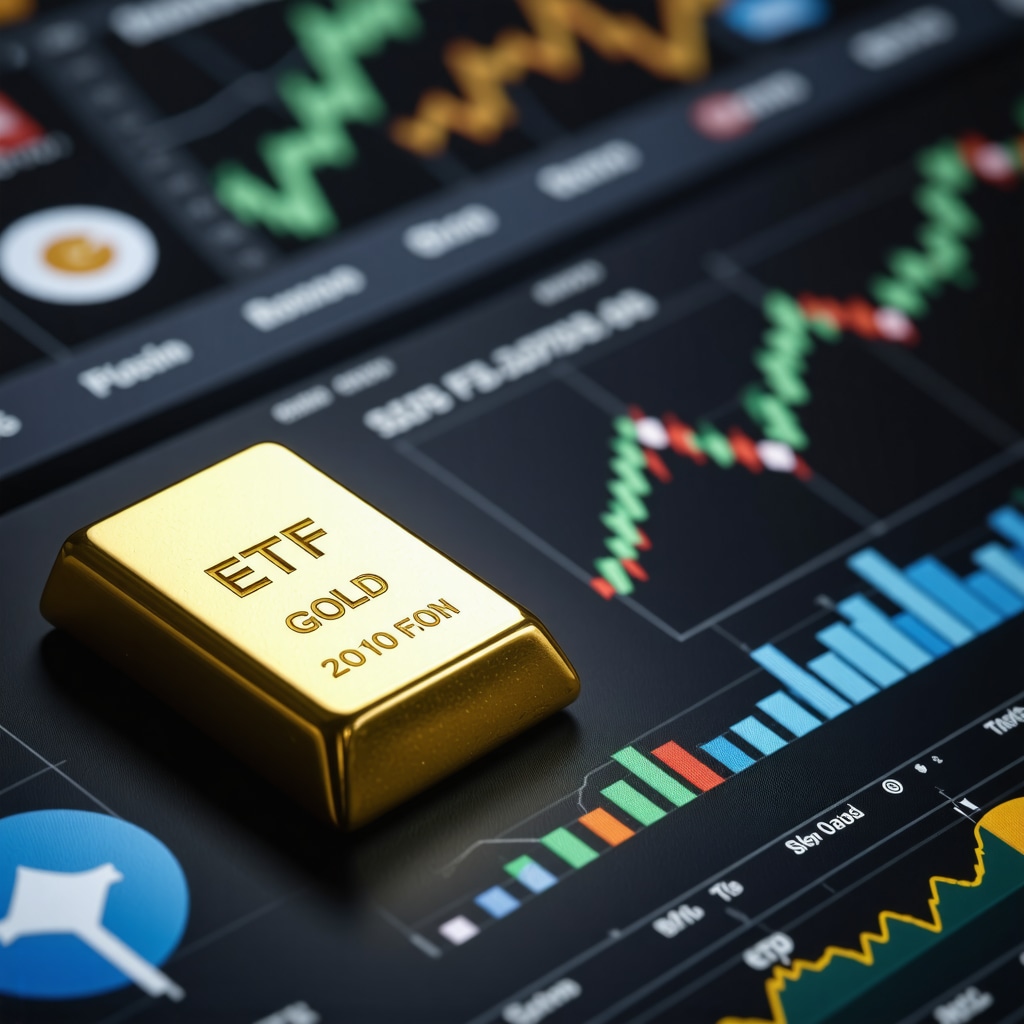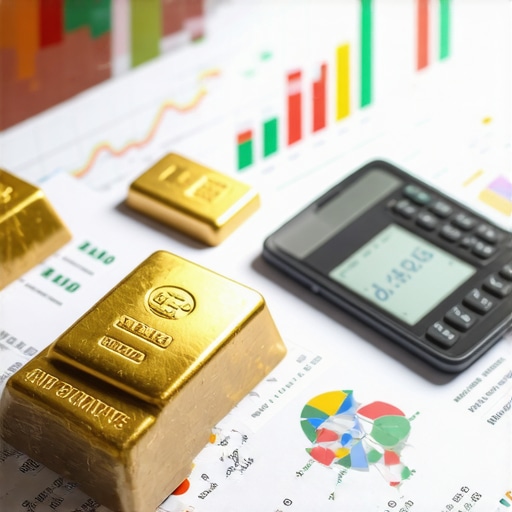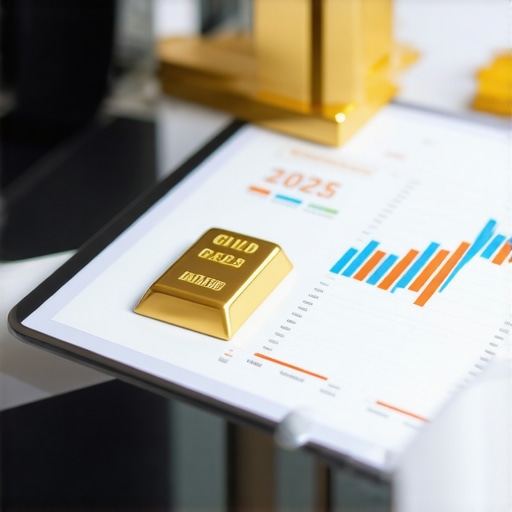Unlocking the Golden Door: Why Gold ETFs Are a Must-Have in Your Investment Arsenal
In an investment landscape often riddled with volatility and uncertainty, gold remains a timeless beacon of stability. However, owning physical gold comes with its own set of challenges—storage, liquidity, and transaction costs. Enter Gold Exchange-Traded Funds (ETFs), a modern gateway that allows investors to harness gold’s intrinsic value without the logistical hassles of physical ownership. This guide unpacks the nuances of Gold ETFs, empowering beginners to diversify their portfolio with confidence and strategic insight.
Beyond the Glitter: Understanding the Mechanics of Gold ETFs
Gold ETFs are investment funds traded on stock exchanges, designed to track the price of gold. Unlike buying physical bars or coins, investing in a Gold ETF means you own shares that represent a specific amount of gold held in custodial vaults. This structure offers liquidity akin to stocks, enabling swift buying and selling during market hours. Moreover, Gold ETFs usually come with lower expense ratios compared to mutual funds, making them cost-effective for long-term holdings.
What Sets Gold ETFs Apart From Other Gold Investments?
While physical gold offers tangible asset security, it demands secure storage and insurance costs. Gold mining stocks introduce company-specific risks tied to operational performance and geopolitical factors. Gold futures are complex and suited for sophisticated traders due to their leverage and expiry dates. Gold ETFs blend the best of these worlds by providing direct exposure to gold prices without ownership complexities, appealing to both novice and seasoned investors.
Practical Insights: How Gold ETFs Can Strengthen Your Portfolio’s Resilience
Consider a scenario where equity markets experience sharp downturns due to economic uncertainty or geopolitical tensions. Historically, gold has often served as a safe haven, appreciating or holding its value when stocks falter. By integrating Gold ETFs into your portfolio, you introduce a hedge against inflation and currency fluctuations. This diversification reduces overall portfolio volatility and protects purchasing power over the long term.
How Should Beginners Approach Investing in Gold ETFs?
Start by evaluating your investment objectives and risk tolerance. Gold ETFs are excellent for medium to long-term diversification but should complement rather than replace other asset classes. Choose ETFs with transparent holdings, low expense ratios, and robust liquidity. It’s also prudent to monitor global economic indicators such as inflation trends and central bank policies, as these significantly influence gold prices. For detailed strategies on building a diversified Gold ETF portfolio, consider resources like this comprehensive guide.
Expert Perspectives: Navigating Risks and Rewards in Gold ETF Investments
While Gold ETFs mitigate many risks associated with physical gold, they are not immune to market fluctuations. Prices can be influenced by factors such as international trade tensions, currency strength, and shifts in investor sentiment. Additionally, some Gold ETFs might use derivatives for exposure, adding layers of complexity. A report by the World Gold Council highlights that understanding these dynamics is crucial for maximizing returns and managing risk effectively (World Gold Council on Gold ETF Trends).
Join the Conversation: Share Your Thoughts on Gold ETF Strategies
Have you integrated Gold ETFs into your portfolio? What challenges or successes have you encountered? Share your experiences in the comments below or spread the knowledge by sharing this guide with fellow investors eager to diversify wisely.
Reflecting on My Journey With Gold ETFs: Lessons Learned
When I first dipped my toes into the world of Gold ETFs, I was understandably cautious. The idea of investing in something intangible yet so deeply tied to physical gold felt a bit abstract. Over time, I realized that the beauty of Gold ETFs lies in their blend of accessibility and gold’s timeless value. One key insight from my experience is the importance of patience. Market fluctuations can be unsettling, but gold’s long-term trajectory often rewards steadfast investors.
For instance, during a recent market dip, I noticed my Gold ETF holdings acted as a cushion, softening the blow from equity losses. This firsthand experience reaffirmed why many financial advisors recommend maintaining a certain percentage of gold exposure in one’s portfolio. If you want to explore tailored strategies, check out this guide on safe and effective gold investment strategies that helped me refine my approach.
Understanding Gold ETF Fees: Why They Matter More Than You Think
One subtle but impactful aspect I learned is how fees can quietly erode returns over time. Gold ETFs typically have expense ratios, which cover management and operational costs. While these fees might seem minimal at first glance, compounding them annually can make a noticeable difference, especially in a low-yield environment.
When choosing a Gold ETF, I always scrutinize the expense ratio alongside liquidity and tracking accuracy. A lower expense ratio often correlates with better performance in the long run. If you want a deep dive into managing these factors, the article Gold Price Forecast 2029: Key Trends to Watch This Year offers insightful perspectives on market dynamics that impact your investment’s cost-effectiveness.
Could Gold ETFs Be the Answer to Balancing Your Portfolio in Turbulent Times?
It’s a question I’ve asked myself many times, especially during volatile market cycles. The allure of Gold ETFs is their ability to provide a hedge without the burdens of physical gold ownership. But how effective are they really in balancing out risk? Based on my experience and research, they can play a significant role in portfolio diversification, but only when integrated thoughtfully.
For example, during periods of inflation or geopolitical instability, gold prices often rise while stocks might falter. Allocating a portion of your portfolio to Gold ETFs can help stabilize returns and preserve capital. However, overreliance without considering other asset classes might limit growth potential. It’s always a balancing act.
Exploring Advanced Tactics: Using Gold ETFs for Tactical Asset Allocation
After getting comfortable with basic investing in Gold ETFs, I ventured into more tactical strategies. This involved adjusting my gold exposure based on market signals such as inflation data, interest rate changes, and central bank policies. The flexibility of Gold ETFs makes this feasible since you can buy or sell shares as market conditions evolve.
One resource that helped me navigate these complexities is the World Gold Council’s research on ETF demand trends, which emphasizes the influence of macroeconomic factors on gold prices (World Gold Council on Gold ETF Trends). Staying informed allowed me to make timely decisions rather than reacting emotionally to market swings.
If tactical allocation sounds intriguing, you might also want to explore gold trading techniques to maximize profits in volatile markets for practical tips and strategies.
How Do You Personally Incorporate Gold ETFs Into Your Investment Strategy?
I’d love to hear your stories and insights. Are you using Gold ETFs as a long-term hedge, or do you prefer more active trading approaches? What challenges have you faced, and what successes have you celebrated? Sharing your experiences can provide valuable perspectives for our community. Feel free to leave a comment below or share this article with fellow investors who might benefit from a fresh take on gold investing.
Strategic Gold ETF Integration: Leveraging Macroeconomic Indicators for Superior Timing
Successful Gold ETF investing transcends mere buy-and-hold tactics; it demands a nuanced understanding of macroeconomic signals that shape gold price trajectories. Inflation rates, central bank monetary policy shifts, and currency fluctuations are pivotal factors. For instance, rising inflation often triggers increased demand for gold as a hedge, while monetary tightening can exert downward pressure on gold prices due to higher opportunity costs.
Seasoned investors monitor Federal Reserve announcements, interest rate trends, and geopolitical developments to dynamically adjust their Gold ETF holdings. This approach aligns with tactical asset allocation principles, allowing investors to optimize portfolio risk-return profiles by increasing exposure during anticipated upside cycles and reducing it when headwinds appear.
How Can Advanced Investors Utilize Gold ETFs to Hedge Against Currency Depreciation and Geo-Political Risks?
Advanced investors often deploy Gold ETFs as a strategic hedge against currency depreciation and geopolitical turmoil, exploiting gold’s historical status as a safe haven asset. When fiat currencies weaken, gold typically appreciates, preserving purchasing power. For example, during episodes of escalating geopolitical tensions, such as trade wars or military conflicts, gold prices tend to rally as market participants seek refuge from uncertainty.
To maximize this hedge, investors may complement their Gold ETF positions with currency-hedged ETFs or diversify across multiple gold-related instruments. According to a detailed analysis by the Investopedia guide on hedging currency risk, integrating Gold ETFs within a broader currency risk management framework can significantly enhance portfolio resilience.
Decoding Gold ETF Tracking Errors: What Every Expert Investor Should Know
Though Gold ETFs aim to mirror the spot price of gold, subtle discrepancies known as tracking errors can erode potential gains. These arise from management fees, fund expenses, and the mechanics of gold custody and trading. Understanding the nuances of tracking error is crucial for investors seeking precision in their gold exposure.
High-quality Gold ETFs typically maintain tracking errors below 0.1%, but variability exists across providers. Expert investors scrutinize factors such as liquidity, bid-ask spreads, and fund structure (physical-backed vs. synthetic) to mitigate tracking risks. The CFA Institute’s research on ETF tracking errors offers an in-depth technical perspective on this phenomenon.
Innovative Gold ETF Strategies: Incorporating Options and Leveraged Products
For those with elevated risk tolerance and sophisticated market knowledge, Gold ETFs can serve as foundations for complex strategies involving options, leveraged ETFs, and derivatives. Utilizing call and put options on Gold ETFs enables investors to hedge downside risk or speculate on price movements with defined risk parameters.
Leveraged Gold ETFs offer amplified exposure to gold price movements, though they require careful management due to volatility decay and path dependency. Such instruments are best suited for short-term tactical plays rather than core portfolio holdings. Consulting with financial advisors specialized in commodities and derivatives is essential before engaging with these products.
Engage and Expand: Share Your Advanced Gold ETF Techniques
Are you employing macroeconomic indicators or derivative instruments to refine your Gold ETF strategy? What sophisticated tools or data sources have enhanced your investment decisions? Join the dialogue by commenting below or connecting with our expert community. Your insights could illuminate new pathways for fellow investors navigating the complexities of gold investment.

Harnessing Quantitative Models for Predictive Gold ETF Allocation
Incorporating quantitative analysis into Gold ETF investment decisions represents a frontier for sophisticated investors seeking to optimize timing and allocation. Advanced portfolio managers employ econometric models and machine learning algorithms that parse historical gold price data alongside macroeconomic indicators such as inflation rates, interest rate differentials, and geopolitical event indices. These models enable predictive insights, facilitating proactive adjustments in Gold ETF exposure to capitalize on anticipated market shifts.
Utilizing such data-driven frameworks requires access to reliable financial datasets and a robust understanding of statistical methodologies. Investors leveraging these tools can achieve a more dynamic portfolio stance, mitigating downside risks while enhancing potential upside during bullish gold cycles.
What Are the Best Quantitative Techniques to Forecast Gold ETF Price Movements Effectively?
Among the arsenal of methods, time-series forecasting models like ARIMA and GARCH are widely recognized for modeling gold price volatility and trends. Additionally, machine learning approaches, including random forests and neural networks, have gained traction for capturing nonlinear relationships and regime shifts in gold markets. These techniques, when calibrated with macroeconomic variables and sentiment indicators, provide nuanced forecasts that can inform tactical Gold ETF rebalancing.
However, the complexity of these models mandates expertise and continuous validation to avoid overfitting and ensure robustness. Combining quantitative signals with qualitative judgment about geopolitical risk and monetary policy developments yields a comprehensive investment approach.
Integrating ESG Considerations in Gold ETF Selection: A New Paradigm
Environmental, Social, and Governance (ESG) criteria are increasingly pivotal in shaping investment decisions, including within the gold sector. Though traditional Gold ETFs primarily track physical bullion, emerging ESG-focused Gold ETFs aim to align exposure with sustainable mining practices and ethical sourcing standards.
For investors prioritizing responsible investing, selecting Gold ETFs that incorporate ESG factors can mitigate reputational risks and support sustainable mining initiatives. The MSCI ESG Investing framework provides a rigorous methodology for evaluating such funds, ensuring alignment with global sustainability goals.
Leveraging Cross-Asset Correlation Analytics to Enhance Gold ETF Portfolio Synergies
Advanced investors often analyze cross-asset correlations to optimize Gold ETF integration within diversified portfolios. By examining dynamic correlations between gold, equities, bonds, and alternative assets, investors can identify periods when Gold ETFs provide maximal diversification benefits.
Utilizing tools like rolling correlation matrices and principal component analysis (PCA) enables detection of evolving market regimes where gold’s safe-haven properties either strengthen or diminish. This informs strategic rebalancing to maintain portfolio resilience across economic cycles.
Collaborating with Experts: Where to Deepen Your Gold ETF Expertise
For practitioners eager to deepen their strategic acumen, engaging with specialized forums such as the CFA Institute’s commodities research community or subscribing to the World Gold Council’s research hub offers authoritative insights and cutting-edge analyses. These platforms provide rigorous empirical studies, market commentary, and advanced educational materials tailored to professional investors.
Take the Leap: Elevate Your Gold ETF Strategy with Data-Driven Insights and ESG Integration
Embracing sophisticated analytical tools and ESG considerations can significantly enhance the efficacy and sustainability of your Gold ETF investments. We invite you to apply these advanced frameworks to your portfolio and share your experiences. Join our expert community by commenting below or connecting through our newsletter to access ongoing updates and discussions on elite gold investment strategies.

Frequently Asked Questions (FAQ)
What exactly is a Gold ETF and how does it differ from owning physical gold?
A Gold Exchange-Traded Fund (ETF) is a financial instrument traded on stock exchanges that represents ownership in gold holdings stored by custodians. Unlike physical gold, which requires secure storage and insurance, Gold ETFs offer liquidity similar to stocks, enabling effortless buying and selling without the logistical challenges of handling physical bullion.
How do Gold ETFs help diversify and stabilize an investment portfolio?
Gold ETFs provide exposure to gold’s price movements, which historically exhibit low or negative correlation with equities and bonds. This makes them effective hedges against inflation, currency depreciation, and geopolitical uncertainties, reducing overall portfolio volatility and preserving capital during market downturns.
What are the main risks associated with investing in Gold ETFs?
While Gold ETFs mitigate risks related to physical storage and security, they remain subject to market price volatility influenced by global economic conditions, currency fluctuations, and investor sentiment. Additionally, some ETFs use derivatives or synthetic structures which can introduce tracking errors or counterparty risks.
How can investors assess and minimize tracking error in Gold ETFs?
Tracking error arises when an ETF’s performance deviates from the underlying gold spot price due to management fees, operational costs, or fund mechanics. Investors should select ETFs with low expense ratios, high liquidity, and transparent physical backing to minimize tracking discrepancies. Reviewing historical tracking performance and fund structure is also advisable.
Are there ESG-compliant Gold ETFs, and why should investors consider them?
Yes, ESG-focused Gold ETFs incorporate environmental, social, and governance criteria by investing in gold sourced from sustainable and ethically managed mining operations. Investors prioritizing responsible investing benefit from reduced reputational risks and alignment with global sustainability goals by choosing such funds.
Can Gold ETFs be used for tactical asset allocation and how?
Absolutely. Investors can adjust their Gold ETF holdings dynamically in response to macroeconomic indicators like inflation trends, interest rate changes, and geopolitical events. This tactical approach leverages gold’s safe-haven properties to optimize portfolio risk-return profiles during varying market cycles.
What advanced quantitative methods are effective for forecasting Gold ETF price movements?
Time-series models such as ARIMA and GARCH are widely used for modeling gold price volatility. Machine learning techniques like random forests and neural networks also capture complex nonlinear patterns. Integrating these models with macroeconomic variables and geopolitical sentiment enhances forecast accuracy for proactive Gold ETF allocation.
How do leveraged and options-based Gold ETF strategies differ from traditional holdings?
Leveraged Gold ETFs amplify exposure to gold price changes but carry higher volatility and risk of decay, suitable mainly for short-term tactical trading. Options on Gold ETFs allow investors to hedge downside risk or speculate with defined limits. Both strategies require advanced knowledge and risk management.
How can Gold ETFs serve as a hedge against currency depreciation and geopolitical risks?
Gold has historically maintained value during currency weakening and geopolitical turmoil. By holding Gold ETFs, investors preserve purchasing power and mitigate losses from fiat currency volatility. Combining Gold ETFs with currency-hedged instruments further enhances this protective effect.
Where can investors deepen their expertise on Gold ETF investing?
Engaging with specialized organizations like the World Gold Council and CFA Institute commodities research community provides rigorous research, market analysis, and educational resources essential for mastering Gold ETF strategies.
Trusted External Sources
- World Gold Council (https://www.gold.org): The leading authority on gold market research, offering detailed reports on Gold ETF demand trends, price forecasts, and investment insights that underpin expert strategies.
- CFA Institute (https://www.cfainstitute.org): Provides comprehensive research and technical analysis on ETF tracking errors, asset allocation, and commodity investing, essential for professional-grade understanding.
- Investopedia (https://www.investopedia.com): Offers expert articles on hedging currency risk and derivatives strategies, elucidating advanced financial instruments used alongside Gold ETFs.
- MSCI ESG Investing Framework (https://www.msci.com/our-solutions/esg-investing): Supplies rigorous methodologies for evaluating ESG compliance in gold investments, aiding responsible investors in fund selection.
- Financial Data Providers & Econometric Research Journals: Sources of quantitative models and machine learning techniques applicable to gold price forecasting and tactical asset management.
Conclusion
Gold ETFs represent a sophisticated yet accessible vehicle to harness gold’s enduring value within diversified investment portfolios. Their ability to combine liquidity, cost efficiency, and direct exposure to gold prices makes them indispensable for both novice and advanced investors seeking stability amid market uncertainties. By understanding fee structures, tracking nuances, and macroeconomic drivers, investors can strategically deploy Gold ETFs to hedge risks, capitalize on market cycles, and align with ESG principles. Incorporating quantitative models and tactical asset allocation further elevates portfolio resilience and performance. We encourage you to integrate these expert insights into your investment approach, share your experiences, and continue exploring authoritative resources to fully unlock the benefits of Gold ETF investing. Join the conversation, apply these strategies prudently, and empower your portfolio with the timeless strength of gold.










